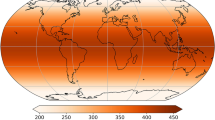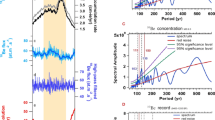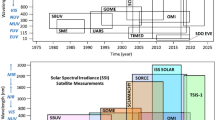Abstract
The time series of total solar irradiance (TSI) satellite observations since 1978 provided by ACRIM and PMOD TSI composites are studied. We find empirical evidence for planetary-induced forcing and modulation of solar activity. Power spectra and direct data pattern analysis reveal a clear signature of the 1.09-year Earth-Jupiter conjunction cycle, in particular during solar cycle 23 maximum. This appears to suggest that the Jupiter side of the Sun is slightly brighter during solar maxima. The effect is observed when the Earth crosses the Sun-Jupiter conjunction line every 1.09 years. Multiple spectral peaks are observed in the TSI records that are coherent with known planetary harmonics such as the spring, orbital and synodic periods among Mercury, Venus, Earth and Jupiter: the Mercury-Venus spring-tidal cycle (0.20 year); the Mercury orbital cycle (0.24 year); the Venus-Jupiter spring-tidal cycle (0.32 year); the Venus-Mercury synodic cycle (0.40 year); the Venus-Jupiter synodic cycle (0.65 year); and the Venus-Earth spring tidal cycle (0.80 year). Strong evidence is also found for a 0.5-year TSI cycle that could be driven by the Earth’s crossing the solar equatorial plane twice a year and may indicate a latitudinal solar-luminosity asymmetry. Because both spring and synodic planetary cycles appear to be present and the amplitudes of their TSI signatures appear enhanced during sunspot cycle maxima, we conjecture that on annual and sub-annual scales both gravitational and electro-magnetic planet-sun interactions and internal non-linear feedbacks may be modulating solar activity. Gravitational tidal forces should mostly stress spring cycles while electro-magnetic forces could be linked to the solar wobbling dynamics, and would mostly stress the synodic cycles. The observed statistical coherence between the TSI records and the planetary harmonics is confirmed by three alternative tests.






Similar content being viewed by others

References
Abreu, J.A., Beer, J., Ferriz-Mas, A., McCracken, K.G., Steinhilber, F.: Astron. Astrophys. 548A, 88A (2012)
Baliunas, S.L., et al.: Astrophys. J. 438, 269 (1995)
Ball, W.T., Unruh, Y.C., Krivova, N.A., Solanki, S., Wenzler, T., Mortlock, D.J., Jaffe, A.H.: Astron. Astrophys. 541, A27 (2012)
Bendandi, R.: Un Principio Fondamentale dell’Universo. S.T.E. Faenza, Italy (1931)
Bigg, E.K.: Astron. J. 72, 463 (1967)
Bond, G., et al.: Science 294, 2130 (2001)
Brown, E.W.: Mon. Not. R. Astron. Soc. 60, 599 (1900)
Caballero, R., Valdes-Galicia, J.F.: Sol. Phys. 213, 413 (2003)
Callebaut, D.K., de Jager, C., Duhau, S.: J. Atmos. Sol.-Terr. Phys. 80, 73 (2012)
Charvátová, I., Střeštík, J.: J. Atmos. Sol.-Terr. Phys. 53, 1019 (1991)
Chylek, P., et al.: Geophys. Res. Lett. 39, L09705 (2012)
Cionco, R.G., Compagnucci, R.H.: Adv. Space Res. 50, 1434 (2012)
Courtillot, V., Le Mouel, J.L., Mayaud, P.N.: J. Geophys. Res. 82, 2641 (1977)
Cuntz, M., Saar, S.H., Musielak, Z.E.: APJ 533, L151 (2000)
Doodson, A.T.: Proc. R. Soc. Lond. Ser. A 100(704), 305–329 (1921)
Duric, N.: Advanced Astrophysics. Cambridge University Press, Cambridge (2004)
Fairbridge, R.W., Shirley, J.H.: Sol. Phys. 10, 191 (1987)
Frick, P., Galyagin, D., Hoyt, D.V., Nesme-Ribes, E., Schatten, K.H., Sokoloff, D., Zakharov, V.: Astron. Astrophys. 328, 670 (1997)
Fröhlich, C.: Space Sci. Rev. 125, 53 (2006)
Ghil, M., et al.: Rev. Geophys. 40, 3.1–3.41 (2002)
Gurdemir, L., Redfield, S., Cuntz, M.: Aust. J. Chem. 29, 141 (2012)
Hung, C.-C.: NASA/TM-2007-214817 (2007)
Jiang, J., Chatterjee, P., Choudhuri, A.R.: Mon. Not. R. Astron. Soc. 381, 1527 (2007)
Jose, P.D.: Astron. J. 70, 193 (1965)
Juckett, D.A.: Sol. Phys. 191, 201 (2000)
Juckett, D.A.: Astron. Astrophys. 399, 731 (2003)
Kelvin (Lord, Thomson, W.): Proc., Inst. Civ. Eng. 65, 3 (1881)
Kilcik, A., Ozguc, A., Rozelot, J.P., Atas, T.: Sol. Phys. 264, 255 (2010)
Kopp, A., Schilp, S., Preusse, S.: Astrophys. J. 729, 116 (2011)
Landscheidt, T.: Sol. Phys. 189, 415 (1999)
Leal-Silva, M.C., Velasco Herrera, V.M.: J. Atmos. Sol.-Terr. Phys. 89, 98 (2012)
Luby, W.A.: Pop. Astron. 56, 252 (1948)
Ogurtsov, M.G., Nagovitsyn, Y.A., Kocharov, G.E., Jungner, H.: Sol. Phys. 211, 371 (2002)
Pap, J., Tobiska, W.K., Bouwer, S.D.: Sol. Phys. 129, 165 (1990)
Press, W.H., Teukolsky, S.A., Vetterling, W.T., Flannery, B.P.: Numerical Recipes in C. Cambridge University Press, Cambridge (1997)
Poppenhaeger, K., Schmitt, J.H.M.M.: Astrophys. J. 735, 59 (2011)
Pikovsky, A., Rosemblum, M., Kurths, J.: Synchronization: A Universal Concept in Nonlinear Sciences. Cambridge University Press, Cambridge (2001)
Qian, W.H., Lu, B.: Chin. Sci. Bull. 55, 4052 (2010)
Rieger, E., Kanbach, G., Reppin, C., Share, G.H., Forrest, D.J., Chupp, E.L.: Nature 312, 623 (1984)
Scafetta, N., West, B.J.: Phys. Rev. Lett. 90, 248701 (2003)
Scafetta, N., Grigolini, P., Imholt, T., Roberts, J.A., West, B.J.: Phys. Rev. E 69, 026303 (2004)
Scafetta, N., West, B.J.: Complexity 10, 51–56 (2005)
Scafetta, N., Willson, R.C.: Geophys. Res. Lett. 36, L05701 (2009)
Scafetta, N.: J. Atmos. Sol.-Terr. Phys. 72, 951 (2010a)
Scafetta, N.: Abstract GC21B-0868 Poster, Presented at 2010 Fall Meeting, AGU, San Francisco, Calif, 13–17 December 2010b
Scafetta, N.: In: Easterbrook, D. (ed.) Evidence-Based Climate Science, vol. 12, p. 289. Elsevier, Amsterdam (2011)
Scafetta, N.: J. Atmos. Sol.-Terr. Phys. 74, 145 (2012a)
Scafetta, N.: J. Atmos. Sol.-Terr. Phys. 80, 124 (2012b)
Scafetta, N.: J. Atmos. Sol.-Terr. Phys. 80, 296 (2012c)
Scafetta, N.: J. Atmos. Sol.-Terr. Phys. 81–82, 27 (2012d)
Scafetta, N., Willson, R.C.: Planet. Space Sci. 78, 38 (2013)
Scafetta, N., Humlum, O., Solheim, J.-E., Stordahl, K.: J. Atmos. Sol.-Terr. Phys. (2013). doi:10.1016/j.jastp.2013.03.007
Scharf, C.A.: Astrophys. J. 722, 1547 (2010)
Sharp, G.J.: Int. J. Astron. Astrophys. (2013, in press)
Shkolnik, E., Walker, G.A.H., Bohlender, D.A.: Astrophys. J. 597, 1092 (2003)
Shkolnik, E., Walker, G.A.H., Bohlender, D.A., Gu, P.-G., Kurster, M.: Astrophys. J. 622, 1075 (2005)
Shravan, M.H., Thomas L.D. Jr., Katepalli, R.S.: Proc. Natl. Acad. Sci. USA 109, 11928 (2012)
Smythe, C.M., Eddy, J.A.: Nature 266, 434 (1977)
Steinhilber, et al.: Proc. Natl. Acad. Sci. USA 109, 5967 (2012)
Sturrock, P.A., Caldwell, D.O., Scargle, J.D.: Astropart. Phys. 26, 174 (2006)
Tan, B.: Astrophys. Space Sci. 332, 65 (2011)
Tan, B., Cheng, Z.: Astrophys. Space Sci. 343, 511 (2012)
Tobias, S.M.: Philos. Trans. R. Soc. A 360, 2741 (2002)
Wang, Z., Wu, D., Song, X., Chen, X., Nicholls, S.: J. Geophys. Res. 117, D07102 (2012)
Willson, R.C., Gulkis, S., Janssen, M., Hudson, H.S., Chapman, G.A.: Science 211, 700 (1981)
Willson, R.C., Hudson, H.S., Fröhlich, C., Brusa, R.W.: Science 234, 1114 (1986)
Willson, R.C., Hudson, H.S.: Nature 351, 42 (1991)
Willson, R.C.: Science 277, 1963 (1997)
Willson, R.C., Mordvinov, A.V.: Geophys. Res. Lett. 30, 1199 (2003)
Wilson, I.R.G., Carter, B.D., Waite, I.A.: Publ. Astron. Soc. Aust. 25, 85 (2008)
Wolf, R.: Mon. Not. R. Astron. Soc. 19, 85 (1859)
Wolff, C.L., Patrone, P.N.: Sol. Phys. 266, 227 (2010)
Wood, R.M., Wood, K.D.: Nature 208, 129 (1965)
Wright, J.T., et al.: Astrophys. J. 683, L63 (2008)
Acknowledgements
The National Aeronautics and Space Administration supported Dr. Willson under contracts NNG004HZ42C at Columbia University, Subcontracts 1345042 and 1405003 at the Jet Propulsion Laboratory.
Author information
Authors and Affiliations
Corresponding author
Rights and permissions
About this article
Cite this article
Scafetta, N., Willson, R.C. Empirical evidences for a planetary modulation of total solar irradiance and the TSI signature of the 1.09-year Earth-Jupiter conjunction cycle. Astrophys Space Sci 348, 25–39 (2013). https://doi.org/10.1007/s10509-013-1558-3
Received:
Accepted:
Published:
Issue Date:
DOI: https://doi.org/10.1007/s10509-013-1558-3



